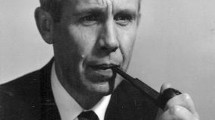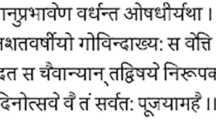Abstract
This Editorial has four goals: (1) to inform the readers of ‘Photosynthesis Research‘ about the past of the ‘Historical corner’; which began 20 years ago; (2) to encourage photosynthesis researchers and historians of science to contact me for publishing papers of historical interest; these include: (a) Obituaries and Tributes; (b) historical papers on current and past discoveries and controversies; (c) history of research in specific laboratories, or in specific countries, or at specific conferences; (d) Personal perspectives (not discussed any further); (3) to encourage researchers not to discard, but to save correspondence and data of their discoveries for the future historians by donating them to their Archives, when appropriate (not discussed any further); and (4) to reinforce to the readers that the concept of two-light reaction and two-pigment system was already there in 1959. I mention here three key papers presented at the IXth International Botanical Congress, held at Montreal Canada (in August, 1959) prior to the famous April 9, 1960 paper by Robert Hill and Fay Bendall on the ‘Z-scheme’ of photosynthesis, that was based on thermodynamic and energetic considerations.
Similar content being viewed by others
Author information
Authors and Affiliations
Corresponding author
Additional information
★ This Historical corner Editorial is dedicated to Bessel Kok (1918–1978).
Appendix 1
Appendix 1
The Time and the Place of the Three 1959 Talks
Four volumes of the proceedings (labeled as Volumes I (Program), II (Abstracts), 2A (Abstracts) and III (Plenary Sessions, Nomenclature) were distributed at the ‘IXth International Botanical Congress, held in Montréal, Canada’ during August 19–29, 1959. Page 145 of Volume I (printed by The Runge Press Limited, Ottawa, 1959) shows the program for the 1st session of the symposium on ‘Photochemistry and Spectroscopy of Chlorophyll in vivo and in vitro’. This session was held on Monday, August 24, 1959, at the Sir Arthur Currie Gymnasium (West) at the McGill University; it was chaired by C.S. French and had 5 speakers (A.A. Krasnovsky at 9:00 AM; A.S. Holt at 9:45 AM; B. Kok at 10:30 AM; A. Pugh and R. Livingston at 11:00 AM; and H.J. Trurnit at 11:30 AM). The title of Bessel Kok’s talk is listed as ‘Does photosynthesis require the interaction of two photochemical steps?’ Page 149 of Volume I shows the program for the final (called ‘concluded’) session of the symposium on ‘Photochemistry and Spectroscopy of Chlorophyll in vivo and in vitro’; it was held in the afternoon of August 24, 1959, and in the same lecture hall as the first session; it was also chaired by C.S. French and had 5 speakers (J.E. Myers at 2: 00 PM; E. Rabinowitch at 2:25 PM; J.H.C. Smith at 2:50 PM; W. Vishniac at 3:10 PM; and G. Tollin at 3:35 PM). The title of Jack Myers’s talk is listed as ‘Evidences for a specific participation of chlorophyll b in photosynthesis’, whereas that of Eugene Rabinowitch as ‘Robert Emerson’s investigations of the action spectra of photosynthesis (In memory of Robert Emerson)’.
The three 1959 abstracts
Volume II A of the proceedings of the ‘IXth International Botanical Congress, held in Montréal, Canada’, printed by the Mortimer Limited (1959), contains the abstracts submitted by the speakers before the Congress.
Page 18 (volume II A) has the following abstract by Bessel Kok:
Kok, Bessel. Research Institute for Advanced Studies, Baltimore, U.S.A. Does photosynthesis require the interaction of two photochemical steps? Based directly on recent different spectroscopic data and indirectly on various other observations, a hypothesis will be discussed which conceives a cycle of two photochemical acts in photosynthesis [bolded by G]. Indicative of these two steps are the formation and disappearance of an absorption band around 700 mμ. Both effects are photo-induced, but the activation spectra are different. In Anacystis, light absorbed by chlorophyll-a or transferred to it causes breakdown [G: equivalent to ‘bleaching’]; in the restoration of the 700 mμ pigment only light absorbed by phycocyanin is active [G: Kok may not have realized prior to the Congress the role of chlorophyll a in this system as he did in the publication cited in the main text above]. It looks as if breakdown is a direct photochemical process whereas the restoration, though photo-induced, requires intermediate dark steps [bolded by G]’.
Page 24 (Volume II A) has the following abstract by Jack Myers:
Myers, Jack. Carnegie Institution of Washington, Stanford and University of Texas, Austin, U.S.A. Evidences for a specific participation of chlorophyll b in photosynthesis. Rate of oxygen evolution in photosynthesis was measured as the current from a platinum electrode covered by a layer of Chlorella cells about 15 μ thick. The arrangement gave a reproducible measurable rate of photosynthesis proportional to light intensity at the low levels used and gave rapid response to changes in illumination. Three phenomena have been explored. (1) The Emerson effect was studied as enhancement of photosynthesis in long wavelength red light (700 mμ) when shorter wavelengths were added. (2) Large and reproducible transients in oxygen evolution were observed accompanying change in illumination between two wavelengths adjusted in intensity to support equal steady rates of photosynthesis. (3) Differences in the time kinetics of photosynthesis were found to be wavelength dependent. The three phenomena have identical action spectra which are interpreted as demonstrating a specific photochemical participation of chlorophyll b in photosynthesis.
Pages 29 and 30 (Volume II A) have the following abstract by Eugene Rabinowitch:
Rabinowitch, Eugene. University of Illinois, Urbana, U.S.A. Robert Emerson’s investigations of the action spectra of photosynthesis (in memory of Robert Emerson). Robert Emerson’s investigations of the photosynthesis action spectra of algae of different classes extended from 1941 to his tragic death in February, 1959, and were characterized from the beginning by clear understanding of the significance of these spectra. He measured maximum quantum yields, in truly monochromatic light, as a function of wavelength, rather than – as others did and still do – the rate of photosynthesis somewhere between the regions of light limitation and light saturation, in broad spectral regions isolated by color filters. Through this work, the contribution of different pigments to photosynthesis were first established reliably and precisely, in Chlorophyceae (Emerson and Lewis, 1941–1943) Diatomeae (Tanadad, 1951 [G: the name should be Tanada]), Cyanophyceae (Emerson and Lewis, 1942) and Rhodophyceae (Emerson and M. Brody, in press). In modern physics, the derivation of new qualitative understanding from precise quantitative measurement of phenomena is a common path of advance; in biology, this path is only rarely available, due to difficulties in precise measurement and the complexity of the phenomena. Emerson’s studies of action spectra were of this rare kind. Among their most recent successes was the discovery, with M. Brody, of the dependence of the relative photosynthetic efficiency of phycobilins and of the chlorophyll in red algae on the pre-treatment of the organisms (which suggests a new aspect of the problem of mutual coupling and energy transfer between the molecules of these pigments in the chloroplasts); and the analysis (with R. Chalmers, C. Cederstrand and M. Brody) of the decline of the efficiency of chlorophyll a in spectral regions where it is the only absorbing pigment – above 680 mμ in green algae and above 650 mμ in red algae. These observations solved the puzzle of ‘inactive chlorophyll a’ in red algae, raised by less precise spectral studies of other investigators, and raised instead a more fundamental puzzle of the specific function of accessory pigments (chlorophyll b in green algae, phycobilins in red algae, etc.) in photosynthesis. Emerson’s last months were dedicated to the attempts to approach this problem in his characteristic way – by further improvement of measurements, and wider variation and better control of the physiological state of the algae (such as composition of the pigment system, intensity of respiration, variations in nutrition) and of possibly relevant physical conditions (such as spatial distribution of the absorption of the far red light, absorbed only by chlorophyll a, and of light of shorter wavelengths, absorbed also – or mainly – by one of the accessory pigments). An attempt will be made in the paper to review as far as possible these unpublished experimental results, and to discuss their significance for our present concepts of the primary photochemical process in photosynthesis.
A partial list of photosynthesis-related scientists attending the Congress
In addition to the speakers mentioned in the first paragraph of this Appendix, the following, among others, were listed to have been members of this IXth International Congress: Mary Belle Allen (USA); Daniel Arnon (USA); Sam Aronoff (USA); Thomas T. Bannister (USA); Andrew A. Benson (USA); Norman Bishop (USA); Lawrence Bogorad (USA); Warren Butler (USA); George Cheniae (USA); V. B. Evstigneev (USSR); Giorgio Forti (Italy and USA); Albert Frey-Wyssling (Switzerland); Clint R. Fuller (USA); Hans Gaffron (USA); Martin Gibbs (USA); Norman Good (then in Canada); Paul Gorham (Canada); Per Halldal (Sweden); Francis T. Haxo (USA); David M. Krogmann (USA); Gleb Krotkov (Canada); Paul Latimer (USA); Ralph Lewin (USA); Berger Mayne (USA); Alex Moyese (France); Kurt Mühlethaler, (Switzerland); Anatoly Nichiporovich (USSR); André Pirson (Germany); Elver Steeman-Nielsen (Denmark); Mary Stiller (USA); Ralph C Stocking (Canada); Hiroshi Tamiya (Japan); Achim Trebst (Germany); Evert C. Wassink (The Netherlands); and Diter von Wettstein (Sweden).
Rights and permissions
About this article
Cite this article
Govindjee Celebrating 20 years of historical papers in Photosynthesis Research★ . Photosynth Res 87, 151–158 (2006). https://doi.org/10.1007/s11120-005-9023-y
Received:
Accepted:
Published:
Issue Date:
DOI: https://doi.org/10.1007/s11120-005-9023-y
Keywords
- (Blinks) chromatic transients
- L.N.M. Duysens
- (Emerson) enhancement effect
- Bessel Kok
- discoveries in photosynthesis
- Eugene Rabinowitch
- historical papers
- IXth (1959) International Botanical Congress
- Jack Myers
- Lawrence Blinks
- obituaries
- personal perspectives
- Robert Emerson
- Robin Hill and Fay Bendell
- C. Stacy French
- tributes
- two-light reaction two-pigment system concept
- ‘Z’-scheme




